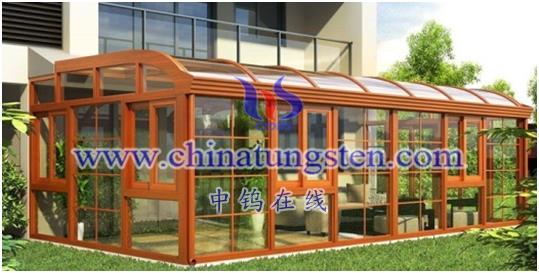Cesium tungsten bronze coating (Cs0.33WO3 coating) can effectively reduce solar heat gain and air conditioning energy consumption of buildings due to its high near-infrared (NIR) absorption capacity. However, due to the obvious light-to-heat conversion efficiency (73%) of the coating, that is, the absorbed solar energy is efficiently converted into heat energy (after 360s of light, the surface temperature of the material increases by 56°C), which will cause the surface of the building glass window Overheating will generate secondary heat radiation, which will affect its thermal insulation performance.
In order to solve the problem of secondary heat radiation generated by cesium tungsten bronze coating (Cs0.33WO3 coating), the researchers combined cesium tungsten bronze with phase change energy storage materials (PCMs, such as paraffin wax) and designed a new type of Energy efficient composite windows. In the preparation process of this kind of composite window, the hexagonal phase Cs0.33WO3 nanoparticles were prepared by the solid phase method, and the Cs0.33WO3/SiO2 composite sol was prepared by the sol-gel method, and the sol was coated on a large area by the knife coating method. Covered on commercial blank glass; then the blank glass and the glass coated with Cs0.33WO3/SiO2 are used to form a glass tank, and the molten paraffin is poured into the glass tank to make a composite window.

When the sunlight is strong, the composite window can absorb infrared light through the Cs0.33WO3/SiO2 coating, reducing the infrared light entering the building. At the same time, the process of paraffin melting and phase transformation inhibits the increase of Cs0.33WO3 coating temperature and secondary heat radiation. When the ambient temperature is low enough, paraffin can gradually release the heat energy stored in the phase change energy storage material to the indoor environment through the solidification phase change process. Therefore, this Cs0.33WO3-paraffin composite window can effectively maintain a stable and comfortable building indoor temperature.
In the self-made temperature measurement building model, the Cs0.33WO3-paraffin composite window can reduce the indoor temperature change and keep the indoor temperature change within 7.3°C, while the indoor temperature change of the blank glass window is within 24.2°C. The composite window is expected to improve the energy-saving efficiency of buildings, and this composite window is more suitable for areas with large diurnal temperature fluctuations or large inter-seasonal temperature fluctuations.
More details of cesium tungsten bronze product, please visit website: cesium-tungsten-bronze.com
Please contact CHINATUNGSTEN for inquiry and order of cesium tungsten bronze:
Email: sales@chinatungsten.com
Tel.: 86 592 5129595






